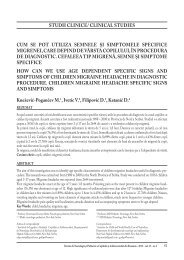Cititi INTREGUL articolul in format .PDF - SNPCAR
Cititi INTREGUL articolul in format .PDF - SNPCAR
Cititi INTREGUL articolul in format .PDF - SNPCAR
You also want an ePaper? Increase the reach of your titles
YUMPU automatically turns print PDFs into web optimized ePapers that Google loves.
CLINICAL STUDIES<br />
CONCLUZII<br />
1.Frecvenţa titrului crescut al enolazei specifice<br />
neuronale este în concordanţă directă cu frecvenţa<br />
acceselor convulsive. Pentru accesele cu frecvenţă înaltă<br />
(de câteva ori pe zi) nivelul enolazei specifice neuronale<br />
a fost majorat în 50% d<strong>in</strong> numărul total de cazuri.<br />
2.Există o corelaţie puternică între prezenţa<br />
retardului neuropsihic și motor și nivelul ridicat al<br />
enolazei specifice neuronale.<br />
3.Deasemenea este remarcată o corelaţie medie<br />
CORNELIA CĂLCÎI • Neuron-specific enolase as marker of bra<strong>in</strong> lesions<br />
între grupul de copii cu vârsta mai mică de 1 lună<br />
și nivelul enolazei. Acest lucru este posibil legat cu<br />
evenimentele hipoxic -ischemice care au loc imediat<br />
după naștere la unii copii.<br />
4. Este remarcată o diferenţă statistică comparativă<br />
d<strong>in</strong>tre variaţiile concentraţiei enolazei până și după<br />
tratamentul cu Ceraxon și Cortex<strong>in</strong>, astfel putem<br />
concluziona că aceste preparate prez<strong>in</strong>tă un factor<br />
de neuroprotecţie în cadrul convulsiilor epileptice la<br />
copii.<br />
*<br />
* *<br />
AIM OF THE STUDY<br />
Emphasis <strong>in</strong> the correlation between child’s<br />
epilepsy (type of convulsive attack, its frequency, the<br />
onset of epilepsy, the presence of neuropsychic delay)<br />
and the serous level of specific neuronal enolase<br />
consider<strong>in</strong>g as well particularities <strong>in</strong> antiepileptic<br />
treatment <strong>in</strong> comb<strong>in</strong>ation with the neuroprotector <strong>in</strong><br />
cases of epilepsy at newborns and babies.<br />
MATERIAL AND METHODS<br />
The follow<strong>in</strong>g study has been performed on the<br />
cl<strong>in</strong>ical bases ICSPIDOSM and C from Chis<strong>in</strong>au city,<br />
<strong>in</strong> the departments of neuropsychiatry of newborns<br />
and psychoneurology and epileptology dur<strong>in</strong>g the<br />
years 2007-2009. For accomplish<strong>in</strong>g the proposed<br />
objectives, <strong>in</strong> the study were <strong>in</strong>volved 108 children<br />
(group I), aged between 2 weeks -24 months (average<br />
age 9,2±1,2 months), among these 61 (56,0%)- boys<br />
and 47 (44,0%) girls. The refference group was made<br />
from 108 children without an anamnesis of convulsive<br />
attaks, practically healthy (group II) of the same age,<br />
among which 49 boys (45,0%) and 59 (55,0%) girls.<br />
Patient’s selection for the research group was<br />
performed accord<strong>in</strong>g to the follow<strong>in</strong>g criteria: (1)<br />
epileptic convulsions of any type or aetiologic, (2)<br />
specific changes at EEG (not obligatory), (3) age (2<br />
weeks -24 months). Children who have manifested<br />
acute convulsions, but which at the moment of<br />
exam<strong>in</strong>ation on EEG the epileptic focci was not<br />
established yet which was also enrolled <strong>in</strong>to the study.<br />
For the patients’ evaluation there was made a special<br />
questionnaire, <strong>in</strong> which there were <strong>in</strong>cludenecessary<br />
data <strong>in</strong> order to collect demographic notes, of<br />
paracl<strong>in</strong>ic and cl<strong>in</strong>ic research: name, surname,<br />
Fig1. Structure accord<strong>in</strong>g to peoples’ sex <strong>in</strong>cluded <strong>in</strong><br />
the study<br />
Lots I<br />
44%<br />
Lots II<br />
55%<br />
56%<br />
45%<br />
boys<br />
girls<br />
boys<br />
girls<br />
per<strong>in</strong>atal anamnesis data, the presence of convulsions<br />
be<strong>in</strong>g of various genesis, the onset of convulsions,<br />
type of convulsions, their length and frequency,<br />
the possible trigger<strong>in</strong>g factor, the <strong>in</strong>tercritic length<br />
period, the presence of convulsions among relatives,<br />
deviations <strong>in</strong> the neurologic status at the moment of<br />
exam<strong>in</strong>ation, antiepileptic used preparations, changes<br />
<strong>in</strong> the studied biologic note values, efficacity <strong>in</strong> the<br />
comb<strong>in</strong>ed adm<strong>in</strong>istered treatment. The type of<br />
epilepsy has been settled on the bases of Epileptic<br />
<strong>in</strong>ternational classification, epileptic syndromes<br />
and as well connected paroxysmal disorders (2000)<br />
(International Lique <strong>in</strong> Epilepsy Control): (1) idiopatic<br />
Journal of Romanian Child and Adolescent Neurology and Psychiatry – March 2013 – vol. 16 – nr. 1 79
















